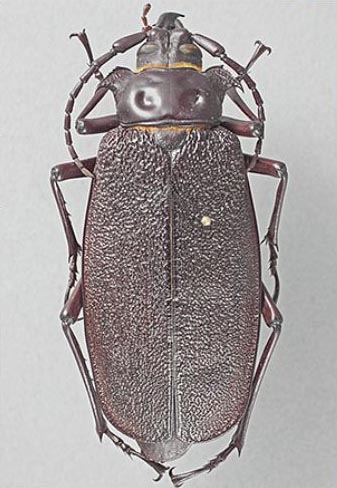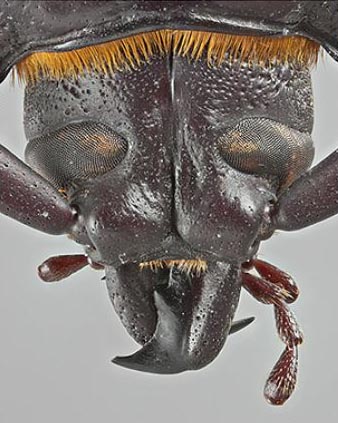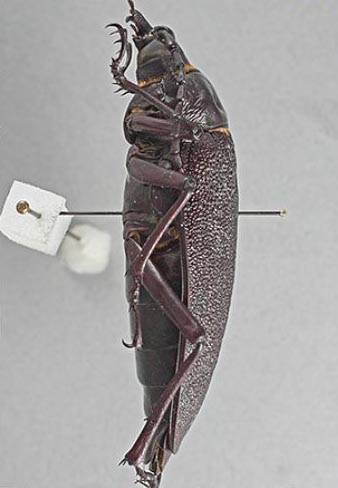 |
Prioninae
Classification
Introduction
- The subfamily Prioninae Latreille, 1802 currently contains ~1,300 species in 20 tribes. Photographs of 137 exemplar specimens are currently available for this subfamily.
Diagnostic Features of Adults
- Antennae borne on raised tubercles. Lateral pronotal carinae complete; or incomplete. Ventral mesotarsal lobes on antepenultimate tarsomere only. Mesoscutum without stridulatory plate. Procoxal cavities externally broadly open. Elytral apices meeting or almost meeting at the suture. Procoxal cavities internally open. Ratio of elytral length to greatest elytral width 1.4-2.5. Metacoxal plates absent. Number of antennomeres 11-20 (Lawrence, 2007).
Diagnostic Features of Larvae
- Larva. Form robust, subcylindrical and tapering posteriorly. Head usually slightly transverse but slightly elongate in certain tropical species; widest behind middle; dorsal margins of epicranial halves fused behind frons but sometimes separating near the base; tentorial cross-arm in same plane as hypostoma, forming a bridge behind it, which divides the occipital foramen into an anterior and posterior portion. Front margin of frons nearly always abruptly sloping, very strongly sclerotized, its lower boundary projecting over clypeus (except Megopis, in part), its upper boundary dentate or carinate (except Indian genera Macrotoma, Sarmydus); six epistomal setae present. Clypeus thick, trapezoidal, as wide at base as epistoma. Labrum thick and lanceolate, cordate, transversely elliptical or orbicular. Mandibles wedge-shaped, cutting edge broadly emarginate; apex produced, acute. Ocelli present or absent. Antenna two- or three-segmented, conical, partially retractile; second segment barrel-shaped or cylindrical, obliquely truncate, hollowed at the tip, and often bearing a small third segment. Subfossal process and postcondylar carina present. Ventral mouthparts attached to hypostoma by slightly more than width of gula. Maxillae movable; cardo distinct; palpifer with outer margin rounded; lobe borne on stipes; maxillary palpi short, conical, robust, three-segmented, the last segment relatively short and cylindrical, blunt or conical, the tip being truncate and bearing a sensory impression. Ligula large, fleshy and densely covered with short stout setae. Prothorax with eusternum partially or entirely and lateral zone distinct. Abdomen with dorsal ampullae with two transverse impressions; ventral ampullae with one. Epipleura protuberant only on last three segments; ninth segment large, elongate, extended. Legs distinct, stout, conical; unguiculus imbricately spinose. Spiracles of mesothorax protruding into prothorax; abdominal spiracles with small marginal chambers occasionally present. Adapted from Duffy (1953).
Geographic Distribution of Subfamily
Biology and Economic Importance
- Biology and economic importance for this taxon coming soon.
Selected References to Adult Specimens
Selected References to Larvae Specimens
|  |

Acanthinodera cumingii
(Hope, 1833); dorsal
♀ specimen
Cerambycidae:Prioninae
Photograph © N.P. Lord

Acanthinodera cumingii
(Hope, 1833); head
♀ specimen
Cerambycidae:Prioninae
Photograph © N.P. Lord

Acanthinodera cumingii
(Hope, 1833); lateral
♀ specimen
Cerambycidae:Prioninae
Photograph © N.P. Lord
|




